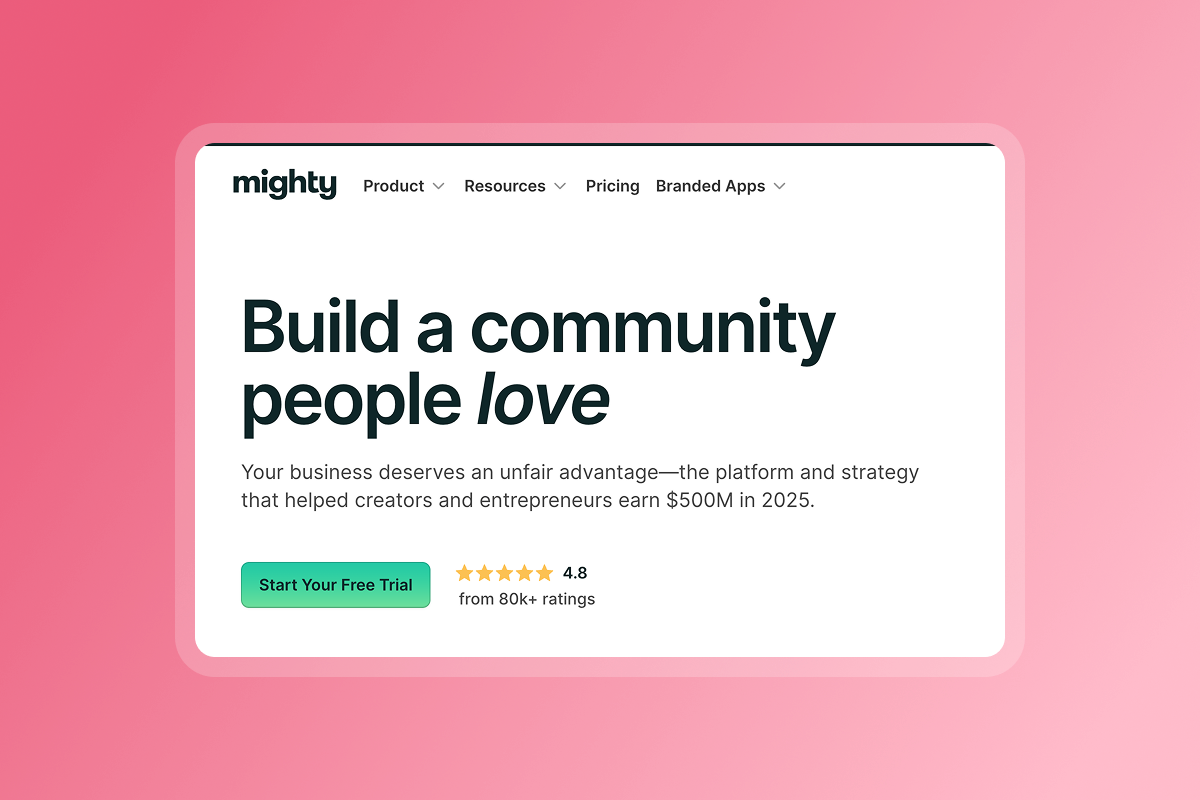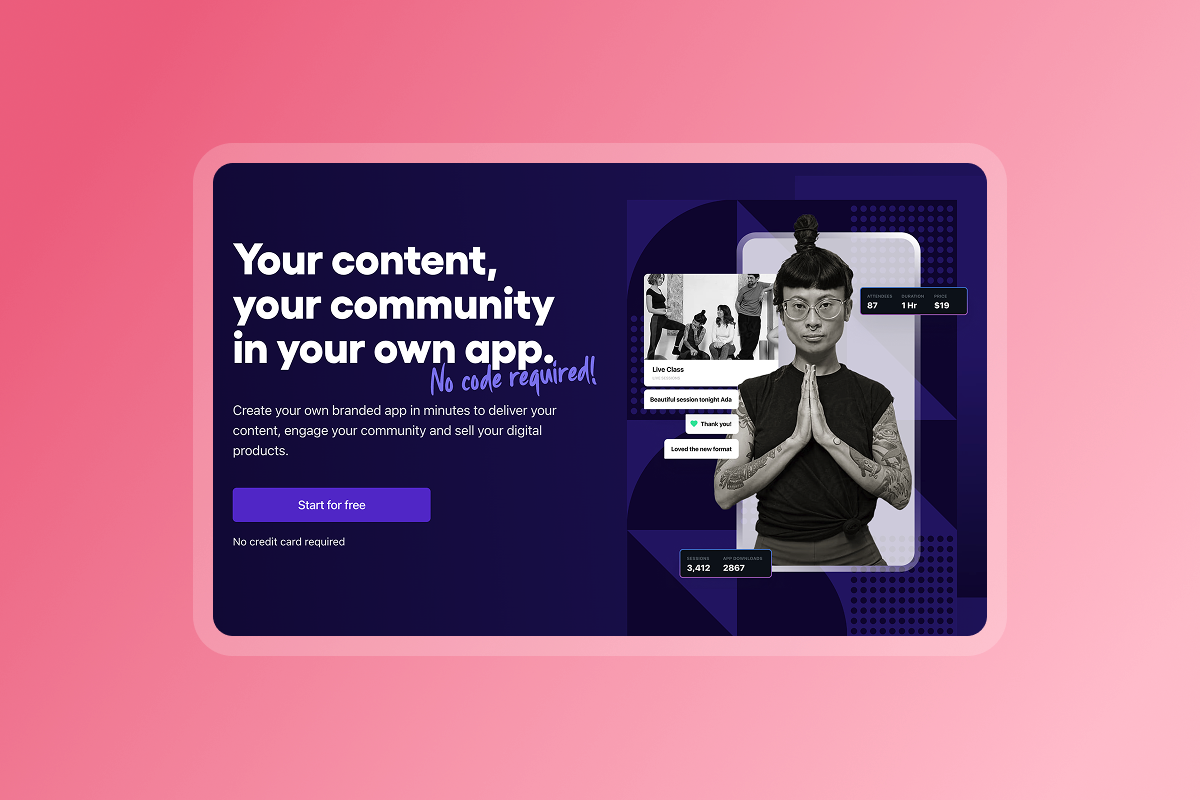Updated 23rd October, 2025
Why seek Passion alternatives? Understanding creator needs
You want to own your audience and steady your recurring revenue. Most creators juggle DMs, a Facebook group, Zoom links, Stripe checkouts, and a separate LMS. Engagement dips. Renewals stall. A branded app with push and community can change that, but the path you choose matters.
Passion’s strengths: native apps and no‑code speed
Passion is built to ship a real branded app on iOS, Android, and web without code. You get templates, interactive lessons, drip schedules, challenges, community, push notifications, and offline playback inside one seamless app experience, with creators also praising Passion’s features, training, and support.
"I love my app and the course that brought me here! The support team is amazing!" — Åsa Lindstedt on TrustPilot
"The steps are detailed, simple, and easy to follow." — Lisa Begley on TrustPilot
Passion’s case studies show launches across fitness, arts, and business with membership revenue tied to app engagement and push habits.
Common motivations for exploring alternatives
- You want an all-in-one web hub with native email, landing pages, pipelines, analytics, and CRM. Kajabi performs well in this area and offers 0% platform transaction fees for Stripe or PayPal, so you only pay your payment processor LitExtension on Kajabi pricing.
- Passion’s lower-tier plans are designed to help creators start affordably, with the option to scale as your audience and revenue grow, according to a BloggingX review.
- You prefer to keep your checkout mostly on the web to avoid app‑store commissions. That tends to favor web‑first stacks with mature funnels and email before you add mobile.
Key criteria for choosing your best platform
Native mobile app capabilities (true native vs. web‑wrapper)
- Passion focuses on true branded native apps plus web, so push notifications, offline access, and community feel integral rather than bolted on. Explore the full list of Passion features, or see it in action in Passion’s short Welcome to a New Passion video.
- Kajabi is web-first. Independent reviewers note that its branded app extension brings your Kajabi content and community to iOS and Android with push notifications, framed as an add-on to the core platform. For a side-by-side walkthrough, check out Mike’s Guides’ I Tested Passion.io vs Kajabi – Which One is Better? (Comparison 2025). Pricing for the add-on is often reported by independent sources and may vary, so it’s best to confirm current terms during evaluation - see the SupplyGem overview for reference.
Community features and engagement tools
- Passion integrates channels, member posts, direct messages, challenges, and push mentions inside the app to create habit loops tied to your content calendar, showcasing how well its features work together.
- Kajabi’s community product emphasizes live rooms, meetups, challenges, points, badges, and leaderboards, along with detailed reporting on member activity through its broader web suite. For more insights, see the SellCoursesOnline explainer and SupplyGem’s take on gamification.
Monetization flexibility and ownership (subscriptions, IAP, external)
- Passion supports subscriptions, one-time purchases, and freemium models. Web checkouts through PassionPayments include a 3.9% platform fee, while in-app purchases on iOS or Android are subject to store fees of 15–30%. Some tiers also allow external checkouts with 0% Passion platform fees for those sales. For more details, see the Passion payments overview.
- Kajabi integrates Stripe and PayPal with 0% Kajabi platform transaction fees. Its payments setup supports modern wallets and buy now pay later options in supported regions, which can help conversion on web checkouts.
Total cost of ownership (TCO) and transparent pricing
TCO is more than the monthly plan. Include payment fees, App Store fees, and time. For native app listings you need Apple at $99 per year and Google Play at $25 one time. On web checkouts, model Stripe’s standard 2.9% plus $0.30 per transaction, then add any platform fee applied by the vendor.
Ease of use and App Store submission support
Passion is a no-code builder with ready-to-use templates and step-by-step guidance. Its higher tiers include deeper support with listings, helping non-technical teams launch faster. Kajabi’s branded app extension, on the other hand, is typically managed through documentation and support while you handle your Apple and Google developer accounts through the add-on flow.
Top Passion alternatives: a detailed comparison
Passion: the mobile‑first app builder
Best for mobile‑first programs where daily nudges, offline workouts, and a clean in‑app community drive completion and renewals.
Passion offers one of the fastest paths to launching a branded native app and web platform for coaches and creators. You get interactive lessons, drip schedules, challenges, offline downloads, an in-app community, and push notifications all within one seamless experience. Monetization supports subscriptions, one-time purchases, freemium models, and in-app purchases when needed. Many creators credit Passion’s training and launch playbooks for helping them attract paying members in just weeks rather than months. For niche success stories, check out Passion’s feature on Menina Fortunato in Dance Your Way to Success on YouTube.
Kajabi: the all‑in‑one business hub
Best for web‑first businesses that rely on funnels and email today and want to add a branded mobile presence later.
Kajabi is a comprehensive web platform for websites, landing pages, email, pipelines, courses, communities, and analytics. Many creators choose it when they want to consolidate marketing and operations on one web stack with mature automation and reporting. Kajabi lists 0% platform transaction fees for Stripe and PayPal. Third‑party sources commonly describe a branded app extension for iOS and Android as an add‑on to bring your web business to mobile with push and in‑app purchases. For a detailed walkthrough, check out “I Tested Passion.io vs Kajabi: Which One Is Better? (2025 Comparison).
Mighty Networks: community‑first approach

Mighty Networks is built around community interaction with events, groups, and member discovery, plus mobile apps for members. It is a fit if your product is the community itself and courses are a companion. Many teams still pair it with other tools for courses or specialized billing. Use independent reviews and demos to confirm your community feature set and mobile experience preferences.
Movement.so: customization and community for coaches

Movement emphasizes coaching spaces and flexible community structures. It can work well for cohort programs that need scheduling, materials, and discussions in the same place. Evaluate customization depth and any mobile experience trade‑offs versus a native‑app‑first approach.
ClickFunnels 2.0: marketing and sales funnels

ClickFunnels 2.0 is designed to maximize conversion with order bumps, upsells, downsells, and split testing. If your near‑term goal is aggressive AOV growth on web, you might pair ClickFunnels with a course or community platform and look at native apps once you have product‑market fit.
SchoolMaker: blended learning and coaching

SchoolMaker focuses on courses and coaching with progress tracking and structured programs. Their public pricing analysis of Passion is a helpful reference when modeling fees and plan limits across platforms.
Other notable alternatives
- Teachable and Podia: Solid for web‑first courses and simple stores. Good for early validation when you do not yet need a branded app.
- LearnWorlds: Course‑centric with strong assessments. Check any mobile solution options if native apps are important.
- Uscreen: Video‑first with OTT distribution and TV apps. A fit if your core product is a video library with subscriptions.
Feature comparison matrix: Passion vs. top alternatives
Table A. Apps, builder, and community
Table B. Monetization, app store support, and starting price
Pricing & total cost of ownership (TCO) breakdown
Passion pricing and fees (PassionPayments, IAP, developer programs)
Plans
- Start with Launch at around $99 per month billed annually, followed by Scale at about $239 and Expand at around $599. Public roundups often cite these figures, but it’s best to confirm the latest plan limits and inclusions at checkout.
Payment paths
- Web checkout through PassionPayments. Adds a 3.9% platform fee on top of Stripe’s processing.
- In‑app purchases. Apple and Google retain 15–30% depending on program and revenue level.
- External checkout on eligible tiers. 0% Passion platform fee. Your processor’s fees still apply.
- Developer programs. Apple Developer Program is $99 per year. Google Play Developer is $25 one time.
Worked example at $10,000 monthly sales on web:
- Assuming 100 transactions at $100 each, Stripe’s 2.9% plus $0.30 per transaction would total about $320. The 3.9% PassionPayments platform fee adds $390, bringing the estimated total to $710 - roughly 7.1% of $10,000. This provides a simple model for margin planning, as discussed in the LitExtension and SchoolMaker pricing analysis.
TCO for key alternatives
- Kajabi plans. Many roundups list Basic near $119 per month billed annually, Growth near $159, and Pro near $319. Kajabi advertises 0% platform transaction fees for Stripe or PayPal.
- The branded app extension is commonly presented in independent guides as a paid add-on, with some citing a price of around $199 per month for courses and community features. Treat this as an estimate and confirm details during evaluation, as packaging and pricing can change, according to the SupplyGem overview.
- For $10,000 in web sales using the same 100-transaction assumption, Stripe’s 2.9% plus $0.30 per transaction comes to about $320, or roughly 3.2% overall. In this scenario, there’s no Kajabi platform transaction fee added on top, as noted in the LitExtension pricing overview.
Choosing your best fit: recommendations for specific creator needs
Best for mobile‑first engagement and recurring revenue
Pick Passion if your program lives on the phone and completion depends on push nudges, challenges, and offline access. The native app becomes home base for content, community, and payments. As one creator put it,
"The support team is amazing!" on TrustPilot.
Best for all‑in‑one marketing and web‑first courses
Pick Kajabi if you want landers, email, pipelines, and analytics in one web suite now. Add a branded mobile app when your audience starts asking for push and in‑app access.
Best for deep community building
Consider a community‑first platform like Mighty Networks when the community experience is the core product and courses are secondary. Pair with a course or app builder as needed.
Best for fitness and wellness coaches
If your members download workouts and need structured challenges with nudges, Passion’s native app, offline mode, and push mentions are a strong match. If you are producing long‑form video libraries across devices, look at Uscreen for OTT delivery and add a community layer.
Your path to an owned, engaged audience
Key takeaways for your decision
- Native apps with push and offline access lift engagement and retention for phone‑first programs.
- Model TCO with plan price, checkout fees, and developer programs. Your margin changes based on web vs IAP.
- Web‑first all‑in‑ones excel at funnels and email. Mobile‑first platforms excel at daily engagement inside your brand.
- Pick the platform that matches how your members consume and pay today, with a clear path to your next 90–180 days.
Next steps for launching your branded app
- Week 1. Define your offer ladder and success metrics. Open Apple and Google developer accounts. Prepare 10 lessons, a 30‑day challenge outline, and your brand kit.
- Week 2. Build your web app, community channels, and pricing tiers. Set web checkout and any IAP products. For structure, follow this launching a no‑code coaching app guide.
- Week 3. Submit iOS and Android listings. Write a 7‑day push cadence for launch and a weekly reminder schedule.
- Week 4. Run your founding member campaign. Onboard the first 50–100 customers. Collect feedback in the community.
Scorecard by day 90:
- Completion up 15–30 percent on your flagship program.
- MRR up 10–20 percent from subscriptions.
- Fewer support tickets as content, community, and payments live together.
Ready to take the next step?
Try Passion risk-free with a 30-day money-back guarantee and start building your branded app today, or book a demo to see how it works in your niche and get real examples tailored to your program.
FAQ:
Does Kajabi include a native mobile app?
- Kajabi is web‑first. Independent guides describe a branded app extension that brings your content and community to iOS and Android as an add‑on.
What extra costs do I need to publish a Passion app?
- Apple Developer Program is $99 per year. Google Play is a $25 one‑time fee. If you sell on the web through PassionPayments, budget a 3.9% platform fee plus your processor’s fees.
Which path has the lowest payment fees on web?
- A simple model for $10,000 in sales with 100 orders shows Stripe at about 3.2% effective. PassionPayments on web adds a 3.9% platform fee on top. In‑app purchases are 15–30%.
How fast can I get live?
- Plan for your web app to be ready in weeks and your store listings to be under review by week 3–4 if your accounts and assets are ready. Keep selling on the web while you wait.
What proof can I see before I decide?
- See recent app wins and feature updates in The New Passion.io Has Arrived. For a side‑by‑side and a hands‑on look, watch the Comparison 2025 and this Passion.io review by Dani’s Tutorials.














